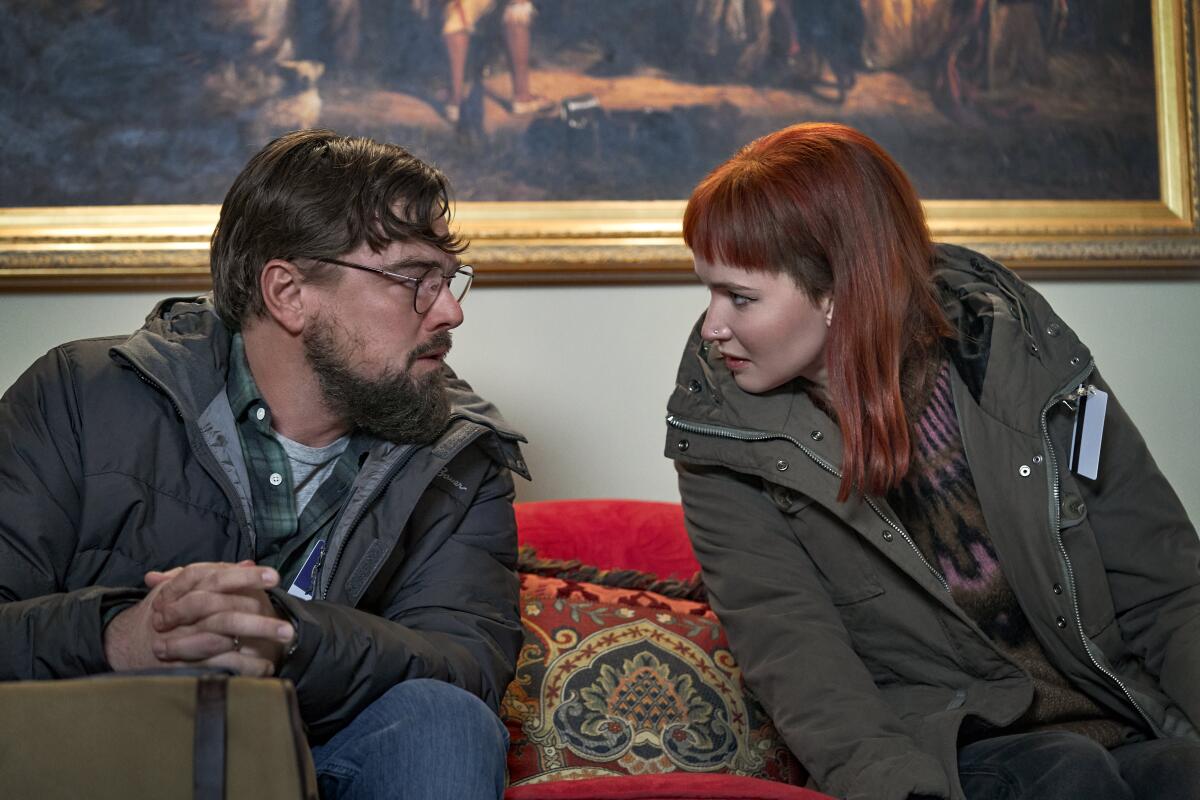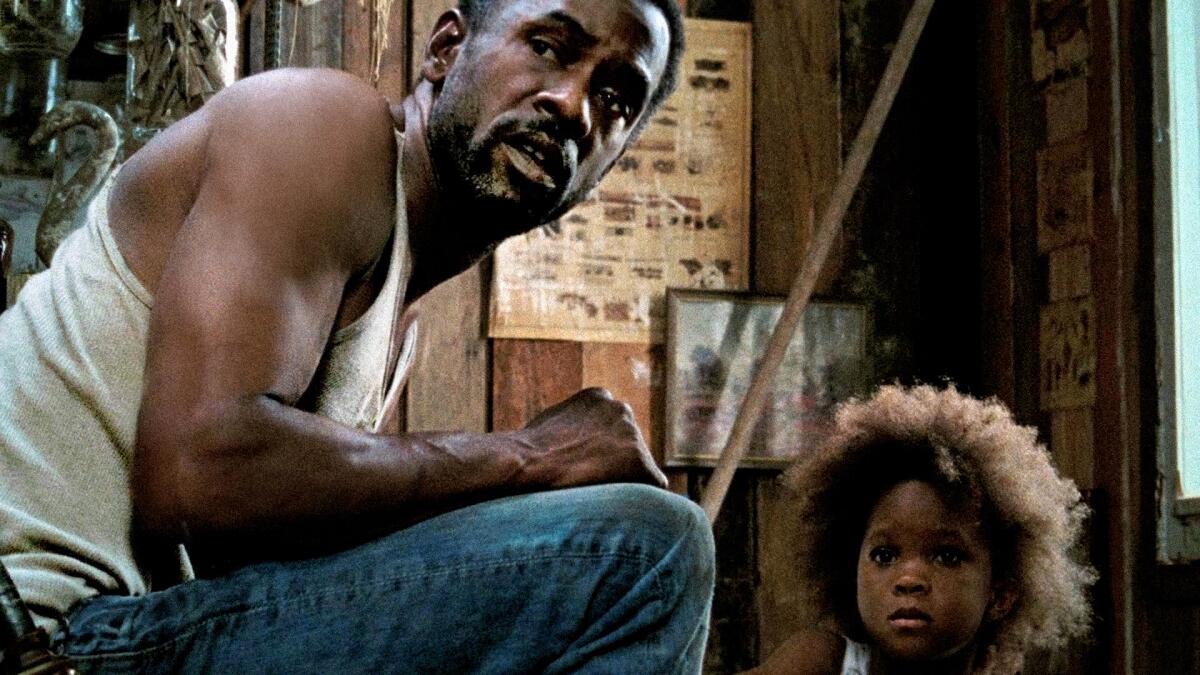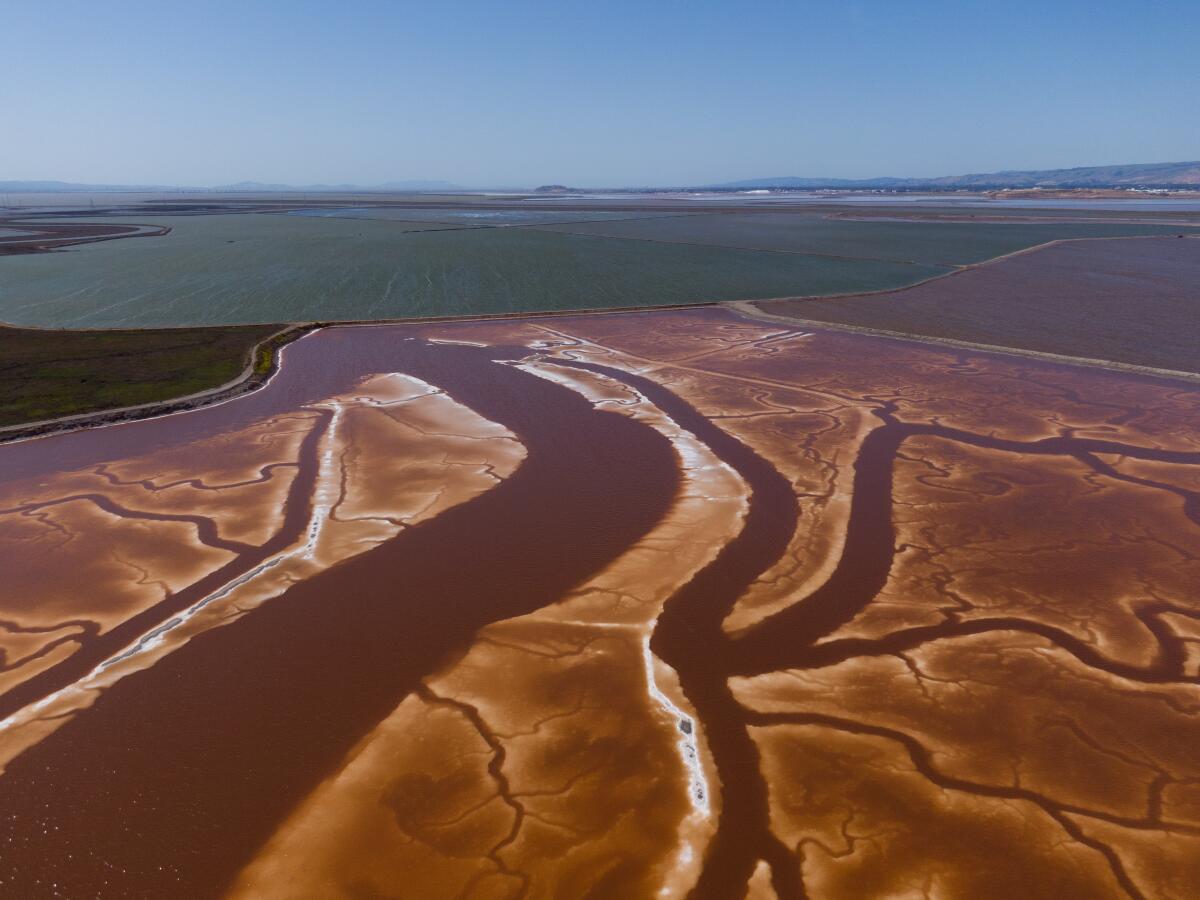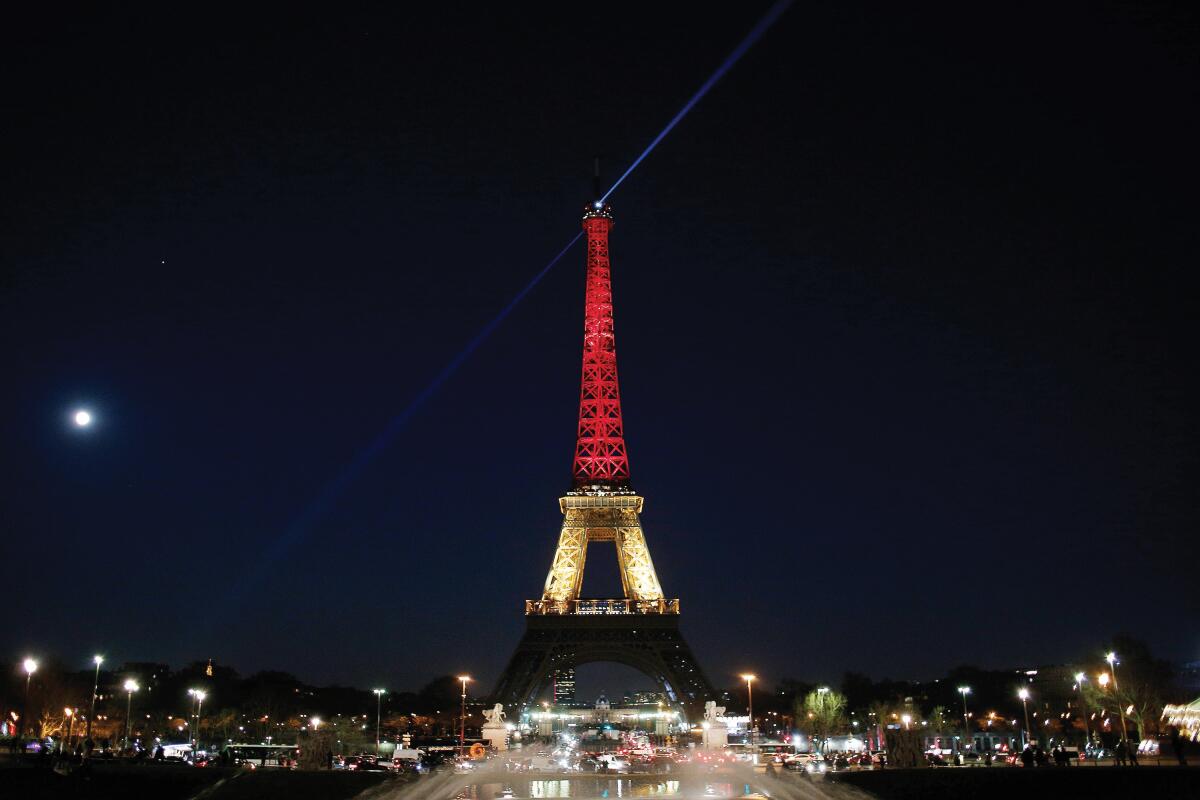Most TV shows and movies ignore climate change. That’s a problem

- Share via
This is the Nov. 3, 2022, edition of Boiling Point, a weekly newsletter about climate change and the environment in California and the American West. Sign up here to get it in your inbox.
The climate crisis is the biggest story of our time. So why isn’t the entertainment industry acting like it?
You’d think liberal Hollywood types — with their Teslas and vegan diets and eco-friendly beauty products — would be chomping at the bit to tell stories about climate. But despite a few high-profile examples — such as “Don’t Look Up” — global warming is largely absent from nearly all the TV shows and movies being produced today, according to a new report out of USC.
The Media Impact Project at USC’s Norman Lear Center analyzed 37,453 scripted television episodes and films released from 2016 through 2020. Researchers found that just 2.8% of those scripts included any mention of climate change — or a long list of related keywords, such as “greenhouse gas,” “sea level,” “clean energy” and “fossil fuel.”
The word “dog” was mentioned almost 13 times as often as all 36 climate keywords put together.
It’s a collective failure of epic proportions — not just for human civilization, but also for TV and film audiences.
“As the crisis worsens and more Americans gain first-hand experience to climate change, stories that do not acknowledge climate will begin to feel irrelevant or divorced from reality,” the report states. “Telling climate stories is not just good for the planet, it is in the best interest of an industry that seeks to engage audiences through authentic characters and narratives.”
As a journalist deep in the climate trenches — and a young person concerned for my own future — I agree that we need climate stories on our screens to help people understand what’s happening and motivate them to fight for solutions.
At the same time, the idea of such a scary topic working its way into my entertainment is, well, kind of scary. As much as some folks loved “Don’t Look Up,” I didn’t especially enjoy it. It made me feel gloomy. Do I really want or need more of that?

Maybe the problem is Hollywood hasn’t given us the right types of climate stories.
Fortunately, the USC researchers didn’t just analyze the words used in scripts. They also surveyed 2,000 American adults with some level of climate concern and explored the different kinds of climate stories on TV and in the movies.
Their findings are fascinating. For instance, 48% of climate-conscious viewers want to see more shows and films with themes related to global warming — and an additional 30% are at least open to it. Perhaps most intriguing, people who feel hopeful about climate solutions are 3½ times more likely to want to see climate narratives on their screens.
Thus far, the best-known climate stories have dealt with apocalypse — see again “Don’t Look Up” or “The Day After Tomorrow” (which despite coming out in 2004 was by far the most common film mentioned by survey participants). But the end-of-world genre can be a turnoff for many viewers — myself included.
“People often feel overwhelmed by the problem, particularly with all the apocalyptic storytelling, the sense that it’s all hopeless,” said Erica Rosenthal, research director at the Norman Lear Center and one of the report’s authors. “That can really hinder the ability to take action. In order for people to take action, they need to believe that change is possible.”
“What these stories can do,” she added, “is foster the belief that change is possible.”
That’s a high-minded vision for studio executives who mostly care about maximizing profits. But there are reasons to believe TV and film can change the way we see and interact with the world — for the better. Rosenthal pointed to previous research finding that the sitcom “Will & Grace” helped reduce prejudice against gay men, and also that the presence of immigrant characters on television can build support for more inclusive immigration policies, at least among some viewers.
Many screenwriters are already working climate into their stories — 2.8% of 37,000 pieces of scripted entertainment is still more than 1,000 scripts. They range from full-on story lines — including a “Madam Secretary” episode about climate refugees — to more glancing references. The highest viewership USC researchers found for any climate reference was a joke on “The Big Bang Theory” about penguins at the Los Angeles Zoo “losing their homes to global warming.”
It’s hard to know for sure whether those types of narratives are changing people’s behavior — what kind of car they drive (if any), how much meat they eat, how much food they waste. But with thoughtful screenwriting, Rosenthal is hopeful.
“It doesn’t have to be a heavy-handed, preachy storyline where one character is yelling at another character,” she said. “Just modeling these behaviors on screen — people start to take notice.”
And as for TV shows and movies provoking larger political change — how people vote, what causes they support, what kinds of conversations they have with their friends and family? That’s even harder to measure. But it might be the wrong question.
Well-crafted entertainment, storytelling consultant Anna Jane Joyner told me, can “create the societal conditions” that allow for change — like how “Will & Grace” helped normalize being gay in the years leading up to gay marriage’s legalization.
“We still need activists and policymakers and organizations pushing for change,” she said.
Joyner founded and leads Good Energy, a nonprofit consulting firm that works with TV and film studios to help them incorporate climate into their stories. The firm funded and helped shape the USC research. It’s received financial support from environmental advocacy groups and others, including the Sierra Club, Bloomberg Philanthropies and the Walton Family Foundation.
I certainly hope more screenwriters, producers and executives will think about building stories around the climate crisis — or even just referencing it. The audience desire exists. Joyner recalled a writer telling her there are two things you never pitch in a writers’ room: abortion and climate change, which are often seen as too polarizing. But polling from the Yale Program on Climate Change Communication has found that two-thirds of Americans are concerned about global warming.
If you’re looking for great climate entertainment, Joyner recommended the 2012 film “Beasts of the Southern Wild,” the Icelandic comedy-drama “Woman at War” (Jodie Foster is planning an English-language version) and the fifth season of “The Affair.”

But even subtle references to our increasingly dangerous planet — and the need to reduce emissions — are worthwhile. When characters on-screen give voice to their climate anxieties, it can help viewers feel seen, the USC researchers wrote. And the more often people hear climate talked about in TV shows and movies, the more likely they are to discuss it in their own lives, too.
“A single mention of climate change isn’t going to motivate people to change their behavior,” Rosenthal said. “But when you have this content repeated over and over again, that’s what normalizes it. That’s what shifts the narrative and creates the cultural conditions for real societal change or policy change.”
For storytellers looking to try this out, Good Energy released a “playbook” for screenwriting in the age of climate change, including world-building ideas, case studies, suggestions for creating realistic characters and tired tropes to avoid.
“We’re not talking about some new kind of story,” Joyner said. “We’re talking about honestly reflecting the world that we live in.”
Journalists might learn from some of this — we traffic in fact, not fiction, but we’re also storytellers. For instance, the USC researchers found that when extreme weather events are mentioned on-screen, they’re linked to the climate crisis only 10% of the time. And when climate does get discussed in TV or film, it’s linked to the fossil fuel industry only 12% of the time.
Those are areas where journalists could be doing a better job too. We’ve all got a responsibility to connect the dots.
On that note, here’s what’s happening around the West:
TOP STORIES
President Biden is following Gov. Gavin Newsom’s lead, threatening oil companies with higher taxes as they rake in record profits amid high gasoline prices. Biden accused Big Oil of “war profiteering” off Russia’s invasion of Ukraine, urging the industry to help reduce gas prices by increasing domestic production, my colleague Courtney Subramanian reports. Newsom, for his part, continued ripping into oil companies, accusing Texas-based Valero of price gouging after it reported $2.82 billion in quarterly profits, per The Times’ Gregory Yee. And despite huge profit margins, Shell and Exxon are selling off tens of thousands of oil and gas wells in California — with the likely result that many of them won’t get plugged, and will leak methane until taxpayers pay to shutter them. ProPublica’s Mark Olalde explains what the heck is going on.
The climate crisis is accelerating in California — and the signs are everywhere. That’s the conclusion of a comprehensive new state report tracking everything from valley fever to disappearing glaciers to extreme heat, as chronicled by my colleague Hayley Smith. None of it is especially surprising — but start pulling out specific threads, and you’ll find global warming still has the power to shock. For instance, Smith also wrote about new research finding nearly a third of conifer forests in the southern Sierra Nevada have been killed by drought or fire in the last decade — nearly a third, in a single decade. Another new study found that nearly 1 million people in the Los Angeles Basin could be hit hard by a climate-fueled “megaflood” — with the risk especially high in Black and low-income neighborhoods, Louis Sahagún and Sean Greene report. And although California reported a drop in climate pollution in its latest annual report, the numbers don’t include wildfires — a huge source of emissions, as Tony Briscoe notes.
The federal government is preparing to slash water releases from Lake Mead and Lake Powell — or at least it’s threatening to do so, in hopes of jump-starting a badly needed deal on the Colorado River. Details here from The Times’ Ian James. Arizona Sen. Mark Kelly, meanwhile, urged the federal officials to withhold funding for restoration of California’s Salton Sea until the state commits to more aggressive water conservation — a move that would result in continued air pollution in disadvantaged communities near the inland lake, as Jonathan J. Cooper and Kathleen Ronayne report for the Associated Press. In one more wild Colorado River story, Grist’s Naveena Sadasivam explains how an Estonian company persuaded a coal-burning Utah utility to help it exploit a loophole in water law — so that the Estonian company can use a bunch of water from a tributary of the Colorado to produce oil.
AROUND THE WEST

The most ambitious tidal wetlands restoration project west of the Mississippi River has been going on for decades in the Bay Area — and with rising seas, it’s more crucial than ever. Here’s the gorgeous story by my colleague Rosanna Xia, with photos by Paul Kuroda and illustrations by Paul Duginski. “Saving a vanishing marsh — while also figuring out what to do with a community that would drown if its existence continued to be overlooked — takes decades if not generations, costs hundreds of millions of dollars and requires the ability to think so long-term and so large-scale that every step seems unprecedented,” Xia writes. I also enjoyed this in-depth piece by Bob Berwyn at Inside Climate News, about the ecosystem restoration success story at California’s Mono Lake — and how climate change has complicated the picture.
A U.S. Forest Service employee in Oregon was arrested by the local sheriff after a prescribed burn designed to reduce fire risk crossed onto private land. Experts say the arrest could have a chilling effect on much-needed burns across the West, as Kylie Mohr reports for High Country News. In another wildfire story, Anna Marshall-Chalmers wrote a powerful piece for Inside Climate News about the historic Black neighborhood in Weed, Calif., that was destroyed by the Mill fire — and why officials and the local timber company didn’t do more to protect that neighborhood, Lincoln Heights, whose history dates to the Great Migration. In Southern California, meanwhile, The Times’ Louis Sahagún writes about a new study finding that mountain lions hate burn scars so much they’re more likely to cross busy roads and get hit by cars.
High-profile UC Davis researcher Frank Mitloehner has vocally argued that eating meat isn’t so bad for the climate, despite a robust body of scientific evidence to the contrary. Well, it turns out the research center Mitloehner leads was conceived of — and is almost entirely funded — by the meat industry. New York Times reporter Hiroko Tabuchi has the receipts.
POLITICAL CLIMATE
In yet another sign of the rising tide of right-wing political violence, a letter laced with a chemical substance and marked with antisemitic symbols was sent to a New Mexico environmental group. The letter included threatening language targeting a state lawmaker who co-sponsored New Mexico’s 100% clean energy law, the Albuquerque Journal’s Dan McKay and Dan Boyd report. It’s discouraging — depressing, even — but there are ways to turn the tide. In Oregon’s Harney County, for instance — site of the 2016 armed takeover of a national wildlife refuge — a collaborative process involving local ranchers, conservationists and government officials has proved effective at beating back extremist ideology, Sarah Trent writes for High Country News.
Conservationists are campaigning for a new 700,000-acre national monument in the California desert south of Joshua Tree National Park. It would stretch from the Mecca Hills — one of my favorite hiking spots — to the Arizona border and would be called Chuckwalla National Monument, Monserrat Solis reports for the Press-Enterprise. The monument would protect microphyll woodlands, desert tortoise habitat and an ancient Native American trade route. Separately, California officials have delayed a decision on whether to protect Joshua trees under the state’s Endangered Species Act, citing the need for more consultation with tribes. Details here from the Desert Sun’s Erin Rode, who notes that the iconic plant is threatened by rising temperatures.
The National Labor Relations Board says environmental advocacy group Defenders of Wildlife unlawfully fired a union organizer in Arizona in an act of retaliation. And although Defenders denies that charge, it wouldn’t be the nonprofit’s first hardball anti-union tactic, Nick Bowlin writes for High Country News. There’s been a recent wave of labor organizing within the environmental movement, with representatives of the Defenders union noting that “people who contribute to organizations like Defenders expect them to live up to principles that they might not expect Apple, Starbucks, or Amazon to uphold.”
THE ENERGY TRANSITION

As California moves toward phasing out the sale of internal combustion engine cars, many independent gas stations will almost certainly go out of business — and/or sell their land to real estate developers. My colleague Daniel Miller previewed the fallout, talking with gas station owners apprehensive about Newsom’s plan to speed the transition to electric vehicles. For now, though, we’re hooked on fossil fuels — just like Europe, where the oil and gas supply situation is so bad amid Russia’s invasion of Ukraine that the Eiffel Tower is shutting off its lights early. One Swiss official even suggested people shower together to save hot water, as The Times’ Jaweed Kaleem and Scott Johnson report in an absolutely mind-bending story. See also my piece from earlier this year about how moving faster on clean energy could help Europe solve these problems.
Sempra Energy has struck a deal to supply clean power to the city of Santa Clara, in the Bay Area, from a wind farm in Baja California, Mexico. This will be Sempra’s third Mexico wind farm, and the company is also planning a battery facility in Mexico that will serve California’s Imperial Valley, per Rob Nikolewski at the San Diego Union-Tribune. Sempra subsidiaries San Diego Gas & Electric and Southern California Gas, meanwhile, are seeking approval from California officials to test injecting hydrogen into natural gas pipelines — a technology that could help fight climate change, but which some climate activists see as greenwashing, Nikolewski reports. In other SoCalGas news, Los Angeles County just gave UCLA researchers a $21-million grant to study the health effects of the record-breaking 2015 gas leak at the company’s Aliso Canyon storage field.
South L.A. is getting a $35-million state climate grant that will fund Metro passes, solar panels, electric car charging stations, tree-planting and more. Here’s the story from The Times’ Dorany Pineda, who writes that the funding will support a largely Black and Latino community where 60% of people live below the poverty line, and where freeways create huge amounts of air pollution. It’s the type of community that’s also likely feeling the stress from rising water costs. But even though an estimated 12% of California households are behind on their water bills, Newsom vetoed legislation offering assistance, Pineda writes.
ONE MORE THING

I’ve been watching “The West Wing” for the first time — yes, I know I’m about 20 years behind — and a few days ago I got to the Season 7 presidential debate episode. It was good timing, considering my focus in this week’s newsletter on climate storytelling. The episode features a full seven minutes in which the candidates debate energy and climate change.
On the one hand, it was fun to watch, and encouraging to think that network TV viewers got treated to a halfway-intelligent climate discussion way back in 2005. On the other hand, it was frustrating to realize how little the conversation has progressed since then. The candidates debated issues that could have been ripped from today’s headlines — drilling in the Arctic, America’s dependence on imported oil, the merits of nuclear energy and the ability of the free market to spur a transition to clean cars.
The Republican candidate also questioned established climate science — sadly still part of our discourse today.
Here’s hoping for TV shows and movies that move the conversation forward — and a viewing public ready to embrace them.
We’ll be back in your inbox next week. If you enjoyed this newsletter, or previous ones, please consider forwarding it to your friends and colleagues. For more climate and environment news, follow me on Twitter @Sammy_Roth.
Toward a more sustainable California
Get Boiling Point, our newsletter exploring climate change, energy and the environment, and become part of the conversation — and the solution.
You may occasionally receive promotional content from the Los Angeles Times.




